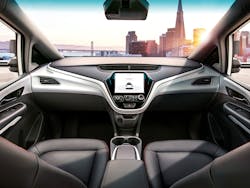Automakers Want Green Light to Remove Driver Controls on Autonomous Cars
If an automaker wants to make an autonomous car, the National Highway Traffic Safety Administration (NHTSA) currently requires the manufacturer to meet 75 different auto safety standards. These standards were developed when all vehicles had human drivers and automated vehicle technologies weren’t yet even on the horizon.
For example, current standards for automobiles assume a human driver is behind the wheel and therefore require manual controls such as steering wheels and brake pedals. Those standards are outdated according to companies like Waymo, General Motors (GM), Lyft, and Honda, which along with other autonomous developers have urged NHTSA to exempt their self-driving prototypes from these regulations to accelerate development.
In response, NHTSA has said that to assess driverless vehicles' compliance with existing standards, it may be necessary to modify regulatory text. To that end, in May, NHTSA sought public comment on a proposed regulation to ease rules for self-driving vehicles (“Removing Regulatory Barriers for Vehicles with Automated Driving Systems, Advanced Notice of Proposed Rulemaking [Docket No. NHTSA-2019-0036]).
Some 90 organizations and individuals submitted comments and several of these responses have just become public. For example, in a letter posted last week, Waymo, the self-driving car unit of Google parent Alphabet, urged NHTSA to act “promptly” to remove regulatory barriers for cars without steering wheels and brake pedals while ensuring “the safe introduction of automated driving systems.”
Pointing out that NHTSA seems to be looking closely at revised crashworthiness standards due to different seating positions in a self-driving car (where occupants may be facing the rear or side of the vehicle), Waymo said new seating positions “are not vital to the development or deployment of autonomous vehicles (AVs). The company adds, “the agency should not focus on seating positions, and instead use resources to address those safety standards that assume a human is behind the wheel before revising rules to address alternative seating configurations.”
In separate comments, Lyft joined Honda in suggesting the agency could recognize self-driving cars as a separate vehicle class to address the rules written, assuming humans would be behind the wheel. “This would allow NHTSA to more expediently remove regulatory barriers and modify Federal Motor Vehicle Safety Standards (“FMVSSs”) that reference a human driver and/or assume some manual control element within the test procedure,” said Lyft.
Crash Avoidance Standards
NHTSA’s Advanced Notice of Proposed Rulemaking focuses on two categories of standards, both within the 100-series reserved for crash avoidance: standards that require a manual control, and standards specifying how the agency will use a manual control in a test procedure.
In its comments, Lyft noted that “manual control requirements in the Federal Motor Vehicle Safety Standards (FMVSS) 100-series impede the development and deployment of Automated Driving System-Dedicated Vehicles (ADS-DVs) in the United States. For example, in FMVSS 108, the manual controls for turn signal actuation devices bear no meaningful relevance for ADS-DVs as there would be no human driver to actuate the turn signal. However, the illumination requirements within FMVSS 108 for the turn-signal lamps to illuminate when turning or switching lanes would remain relevant to ADS-DVs for conspicuity purposes. There, an ideal solution would be for NHTSA to remove the requirements for manual controls but retain the illumination requirements for ADS-DVs, while leaving the FMVSS unchanged for traditional vehicles.”
In early 2018, General Motors, along with robotics and machine-learning company Nuro, petitioned NHTSA requesting a two-year waiver from certain FMVSS regulations such as those requiring brake pedals or steering wheels, to allow for the deployment of such vehicles on public roads.
GM has developed a self-driving Chevy Bolt without a steering wheel or pedals. (Source: GM)
“GM/Cruise supports NHTSA establishing new definitions that apply only to ADS-DVs without manual controls,” the automakers said in its recent comments to NHTSA. “It would allow NHTSA to clearly delineate, where necessary, the requirements that apply to ADS-DV versus those that apply to traditional vehicles. Expanding upon this approach, NHTSA may want to consider creating a new series of requirements that apply to vehicles operated by an ADS-DV without traditional controls.”
GM noted the importance of NHTSA, industry, and the public continuing “to assess how a compliance model premised on traditional automotive engineering principles and historic Vehicle Safety Act interpretations might be reformed to reflect the nearing reality of commercially available autonomous vehicles.”
Comments filed by these and other automakers suggest that it will take the NHTSA at least until 2025 to complete a comprehensive rewrite of its various safety standards.


